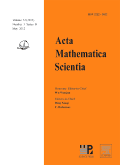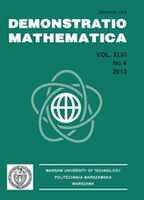
Complex Analysis and Operator Theory
metrics 2024
Innovating Solutions in Applied Mathematics
Introduction
Complex Analysis and Operator Theory, published by Springer Basel AG, is a renowned journal in the field of applied and computational mathematics, reflecting a strong engagement with contemporary mathematical challenges. With an ISSN of 1661-8254 and E-ISSN 1661-8262, this journal provides a platform for disseminating significant findings and innovative methodologies that contribute to the advancement of complex analysis, operator theory, and their diverse applications. As a valuable resource for researchers and practitioners alike, it features high-quality peer-reviewed articles that rigorously explore both theoretical and practical aspects of mathematics. Although it currently does not offer open access, readers can access its insightful content through institutional subscriptions or individual purchases. Since its inception in 2007, the journal has carved a niche for itself, evidenced by its placement in the Q2 quartiles in both Applied Mathematics and Computational Mathematics, and its recognition in Computational Theory and Mathematics. With an ambitious goal to foster the dialogue between theory and practice, Complex Analysis and Operator Theory continues to support the mathematical community from its base in Basel, Switzerland.
Metrics 2024
 0.50
0.50 0.70
0.70 0.80
0.80 28
28Metrics History
Rank 2024
Scopus
IF (Web Of Science)
JCI (Web Of Science)
Quartile History
Similar Journals

ACTA SCIENTIARUM MATHEMATICARUM
Pioneering Insights into Applied MathematicsACTA SCIENTIARUM MATHEMATICARUM, published by SPRINGER BIRKHAUSER in Switzerland, is a distinguished journal focusing on the fields of mathematical analysis and applied mathematics. With an ISSN of 0001-6969 and an E-ISSN of 2064-8316, this journal serves as a critical platform for disseminating high-quality research that bridges theoretical and practical aspects of mathematics. Although currently categorized in the Q3 quartile for both Analysis and Applied Mathematics as of 2023, the journal strives to enhance its impact on the mathematical community by offering a perfect blend of rigorous research and innovative applications. Researchers, professionals, and students can benefit from the journal’s commitment to advancing knowledge in mathematics, despite the absence of open-access options. The mailing address for correspondences is 233 SPRING STREET, 6TH FLOOR, NEW YORK, NY 10013. As mathematics continues to evolve, ACTA SCIENTIARUM MATHEMATICARUM positions itself as a valuable resource for those looking to contribute to and stay informed about the latest developments in this vibrant field.

ACTA MATHEMATICA SCIENTIA
Connecting Theory with Real-World ApplicationsACTA MATHEMATICA SCIENTIA is a reputable academic journal published by Springer, primarily focusing on the interdisciplinary fields of mathematics and physics. With an ISSN of 0252-9602 and an E-ISSN of 1572-9087, the journal has established itself as an influential platform for researchers and professionals seeking to disseminate novel findings in these domains. Based in the Netherlands, the journal holds a commendable Q2 category ranking in both Mathematics and Physics & Astronomy for 2023, reflecting its significance in the academic community. With a focus extending from 1996 to 2024, ACTA MATHEMATICA SCIENTIA serves as a vital resource for scholars, offering insights that bridge theoretical and applied sciences. Published under rigorous peer review, the journal fosters a robust scholarly dialogue and encourages innovative research that challenges existing paradigms. While access is not open, the journal's contributions are of paramount importance for advancing knowledge in the mathematical sciences and their applications in physical contexts.

Demonstratio Mathematica
Elevating the Standards of Mathematical InquiryDemonstratio Mathematica, published by DE GRUYTER POLAND SP Z O O, is an esteemed open-access journal in the field of mathematics, with an ISSN of 0420-1213 and E-ISSN 2391-4661. Established in 1996 and providing open access since 2009, it has become a vital platform for disseminating innovative research and advancements in various areas of mathematics. With a commendable Scopus ranking of 85/399 in General Mathematics and a 2023 Category Quartile of Q2, it stands at the forefront of the mathematical community, demonstrating a significant impact within the top 78th percentile. The journal aims to foster a deeper understanding and appreciation of mathematical concepts and their applications, catering to both seasoned researchers and emerging scholars. Located in Warsaw, Poland, Demonstratio Mathematica not only enriches the academic discourse but also strengthens collaborative efforts within the international mathematics community, making it an essential resource for those seeking to expand their knowledge and research output.

Journal of Contemporary Mathematical Analysis-Armenian Academy of Sciences
Fostering Growth in Contemporary Mathematical ResearchThe Journal of Contemporary Mathematical Analysis, published by PLEIADES PUBLISHING INC, is a prominent peer-reviewed journal dedicated to advancing the field of mathematics. With ISSN 1068-3623 and E-ISSN 1934-9416, this journal serves as a platform for scholars to disseminate innovative research in various subfields, including analysis, applied mathematics, control, and optimization. Established in 2009 and running until 2024, the journal is recognized in the Q4 category across its domains, reflecting its evolving impact within the academic community. Despite currently ranking in the lower quartiles according to Scopus metrics, it is an invaluable resource for emerging researchers and professionals seeking to contribute to and engage with contemporary mathematical theories and applications. The journal’s focus on bridging theory with practical application makes it essential for those working at the intersection of mathematics and its diverse real-world applications.

Pure and Applied Mathematics Quarterly
Pioneering Insights in Pure and Applied MathematicsPure and Applied Mathematics Quarterly is a prestigious journal published by INT PRESS BOSTON, INC, focusing on the diverse and evolving field of mathematics. Since its inception in 2007, this journal has grown significantly, currently holding a Q1 ranking in the Mathematics (Miscellaneous) category for 2023, positioning it among the leading publications in the discipline. With a commitment to publishing high-quality research, Pure and Applied Mathematics Quarterly fosters innovation and dialogue within the mathematical community by providing a platform for theoretical advancements and practical applications. The journal remains accessible to researchers and professionals through its ISSN 1558-8599 and E-ISSN 1558-8602, although it does not currently offer open access. As a vital resource for mathematicians, educators, and students, this journal endeavors to expand the frontiers of mathematical knowledge and contribute to the academic dialogue surrounding this fundamental science.

Computational Methods and Function Theory
Fostering collaboration through rigorous mathematical exploration.Computational Methods and Function Theory is a distinguished journal published by SPRINGER HEIDELBERG, dedicated to advancing the fields of computational mathematics and functional analysis. With its ISSN 1617-9447 and E-ISSN 2195-3724, this journal serves as a vital resource for researchers, professionals, and students seeking to explore state-of-the-art methodologies and theoretical developments from 2011 to 2024. Its robust ranking positions it in the Q3 category for Analysis and Computational Theory and Mathematics, and Q2 for Applied Mathematics, reflecting the journal's influence and credibility within the scientific community. Residing in Germany, the journal promotes open dialogue and innovative solutions to complex mathematical problems, making significant contributions to both theoretical and applied disciplines. Its impact is evidenced by strong Scopus rankings, asserting its relevance and rigorous peer-review processes, which ensure high-quality publications. This journal stands as a key platform for disseminating groundbreaking research and fostering collaboration across disciplines.

Concrete Operators
Advancing Mathematical Frontiers with Concrete InsightsConcrete Operators is an innovative academic journal published by DE GRUYTER POLAND SP Z O O, specializing in the fields of Analysis and Applied Mathematics. With an ISSN of 2299-3282, this open access journal has been dedicated to fostering scholarly communication since its inception in 2013. Concrete Operators aims to provide a platform for researchers, professionals, and students to explore and disseminate significant findings in mathematical analysis and its practical applications. Housed in Germany, with administrative offices located in Warsaw, Poland, the journal embraces a global audience. Notably, as of 2023, it holds a Q4 category ranking in the respective mathematical domains, reflecting its commitment to emerging research within the community. The journal's open access model enhances visibility and accessibility, encouraging collaboration and innovation among mathematicians. By bridging theoretical advances with practical implementations, Concrete Operators plays a vital role in the advancement of mathematical sciences.

FUNCTIONAL ANALYSIS AND ITS APPLICATIONS
Advancing Knowledge in Functional Analysis and BeyondFUNCTIONAL ANALYSIS AND ITS APPLICATIONS, published by PLEIADES PUBLISHING INC, stands as a pivotal resource within the fields of functional analysis and applied mathematics. Since its inception in 1967, this journal has been dedicated to disseminating innovative research that bridges theoretical frameworks and practical applications in mathematics. With an ISSN of 0016-2663 and an E-ISSN of 1573-8485, it caters to a deeply scholarly audience, providing insightful articles that contribute to the broader discourse in mathematics. Notably, it currently holds a Q3 classification in both Analysis and Applied Mathematics categories for the year 2023, reflecting its steady contribution to advancing these disciplines. Although not an Open Access journal, FUNCTIONAL ANALYSIS AND ITS APPLICATIONS plays a crucial role in fostering academic growth and collaboration, making it an essential asset for researchers, professionals, and students aiming to stay abreast of developments in mathematical analysis. Whether exploring pure theoretical concepts or their diverse applications, readers will find valuable insights that challenge and elevate their understanding of functional analysis.

Annales Fennici Mathematici
Pioneering Research in Contemporary MathematicsAnnales Fennici Mathematici is a prestigious academic journal published by Suomalainen Tiedeakatemia based in Helsinki, Finland. With an ISSN of 2737-0690 and an E-ISSN of 2737-114X, this journal has quickly established itself as an essential resource in the field of mathematics since its inception in 2021. It boasts an impressive Q1 categorization in Mathematics (miscellaneous) for 2023, highlighting its impact among top-tier mathematical publications. Currently, it holds a Scopus rank of #135 out of 399 in General Mathematics, placing it in the 66th percentile among its peers, ensuring visibility and relevance for its published works. The journal is committed to providing a platform for innovative research and the dissemination of mathematical discoveries, making it an invaluable resource for researchers, professionals, and students looking to expand their knowledge and engage with contemporary mathematical challenges.

JOURNAL OF OPERATOR THEORY
Advancing Mathematical Frontiers in Operator TheoryJOURNAL OF OPERATOR THEORY is a distinguished periodical published by the THETA FOUNDATION based in Romania. With a specific focus on the realms of mathematics, particularly in the areas of operator theory and its applications in algebra and number theory, this journal plays a crucial role in disseminating high-quality research that advances theoretical understanding and practical applications. It is indexed with an impressive rank of #58 out of 119 in the Scopus Mathematics category, placing it within the 51st percentile nationally. The journal has evolved significantly since its establishment, with publications spanning from 1996 through 2024, and maintaining a reputable stature in the Q2 quartile for Algebra and Number Theory as of 2023. While it operates under a subscription model, the JOURNAL OF OPERATOR THEORY remains an essential resource for researchers, professionals, and students seeking to engage deeply with contemporary mathematical issues and promote advancements in the field. For those looking to explore innovative findings and methodological approaches, this journal is indispensable.